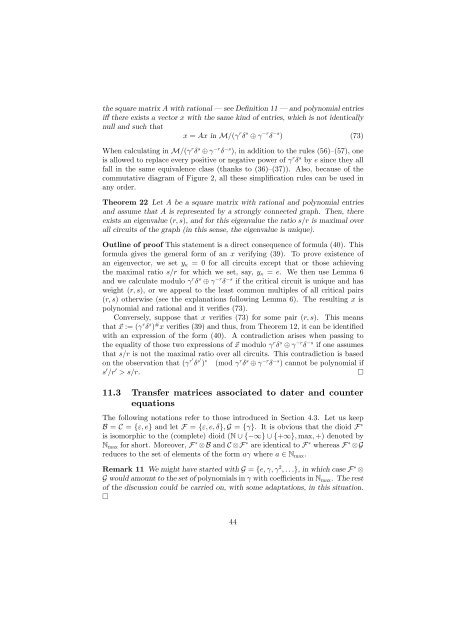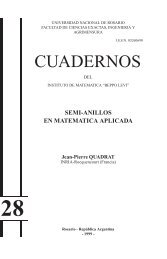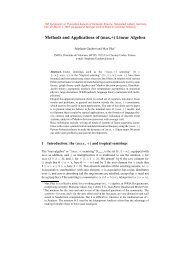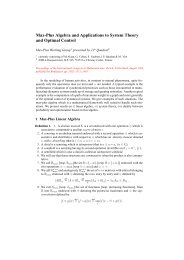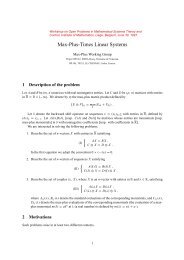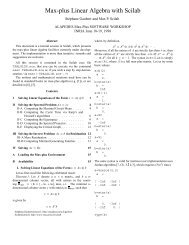View - Jean-Pierre QUADRAT - Free
View - Jean-Pierre QUADRAT - Free
View - Jean-Pierre QUADRAT - Free
You also want an ePaper? Increase the reach of your titles
YUMPU automatically turns print PDFs into web optimized ePapers that Google loves.
the square matrix A with rational — see Definition 11 — and polynomial entriesiff there exists a vector x with the same kind of entries, which is not identicallynull and such thatx = Ax in M/(γ r δ s ⊕ γ −r δ −s ) (73)When calculating in M/(γ r δ s ⊕ γ −r δ −s ), in addition to the rules (56)–(57), oneis allowed to replace every positive or negative power of γ r δ s by e since they allfall in the same equivalence class (thanks to (36)–(37)). Also, because of thecommutative diagram of Figure 2, all these simplification rules can be used inany order.Theorem 22 Let A be a square matrix with rational and polynomial entriesand assume that A is represented by a strongly connected graph. Then, thereexists an eigenvalue (r, s), and for this eigenvalue the ratio s/r is maximal overall circuits of the graph (in this sense, the eigenvalue is unique).Outline of proof This statement is a direct consequence of formula (40). Thisformula gives the general form of an x verifying (39). To prove existence ofan eigenvector, we set y κ = 0 for all circuits except that or those achievingthe maximal ratio s/r for which we set, say, y κ = e. We then use Lemma 6and we calculate modulo γ r δ s ⊕ γ −r δ −s if the critical circuit is unique and hasweight (r, s), or we appeal to the least common multiples of all critical pairs(r, s) otherwise (see the explanations following Lemma 6). The resulting x ispolynomial and rational and it verifies (73).Conversely, suppose that x verifies (73) for some pair (r, s). This meansthat ⃗x := (γ r δ s ) # x verifies (39) and thus, from Theorem 12, it can be identifiedwith an expression of the form (40). A contradiction arises when passing tothe equality of those two expressions of ⃗x modulo γ r δ s ⊕ γ −r δ −s if one assumesthat s/r is not the maximal ratio over all circuits. This contradiction is basedon the observation that (γ r′ δ s′ ) ∗ (mod γ r δ s ⊕ γ −r δ −s ) cannot be polynomial ifs ′ /r ′ > s/r.□11.3 Transfer matrices associated to dater and counterequationsThe following notations refer to those introduced in Section 4.3. Let us keepB = C = {ε, e} and let F = {ε, e, δ}, G = {γ}. It is obvious that the dioid F ∗is isomorphic to the (complete) dioid (N ∪ {−∞} ∪ {+∞}, max, +) denoted byN max for short. Moreover, F ∗ ⊗B and C⊗F ∗ are identical to F ∗ whereas F ∗ ⊗Greduces to the set of elements of the form aγ where a ∈ N max .Remark 11 We might have started with G = {e, γ, γ 2 ,...}, in which case F ∗ ⊗G would amount to the set of polynomials in γ with coefficients in N max . The restof the discussion could be carried on, with some adaptations, in this situation.□44


